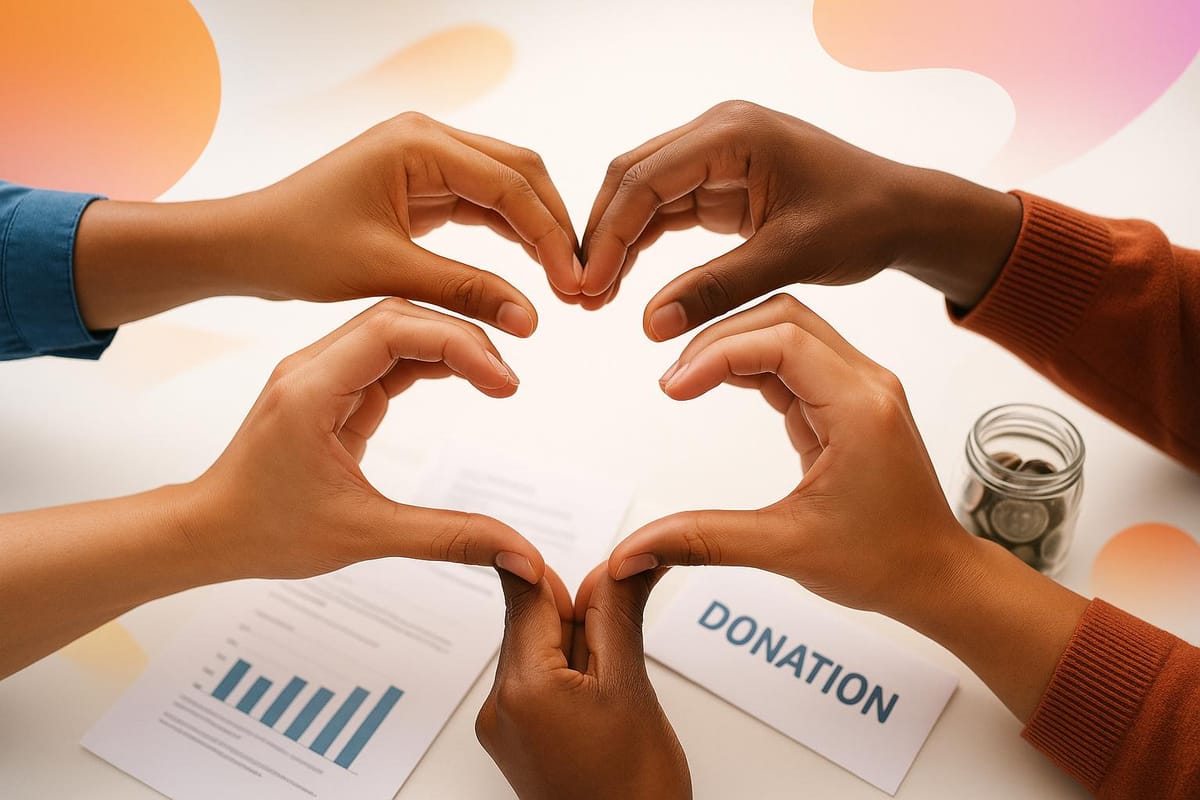How to Boost Donor Retention and Year‑End Fundraising
Discover proven strategies to enhance donor retention and maximize year-end fundraising efforts for your nonprofit.

Nonprofit professionals know all too well that fundraising is a challenging and evolving landscape. With external pressures like funding cuts, shifting donor behaviors, and increasing demand for services, the need for intentional, strategic planning is more critical than ever. In a recent conversation with Jenna Lynch, education and community engagement manager at Donorbox, key insights and actionable strategies emerged that nonprofits can adopt to improve donor retention and maximize their end-of-year fundraising campaigns.
This article will guide nonprofit leaders and fundraisers through a clear framework to strategically prepare for year-end campaigns, retain donors, and foster meaningful connections. Whether you’re a solo fundraiser or part of a larger team, these insights can help you navigate uncertainty with greater clarity and purpose.
Why Fundraising Feels Harder in 2025: The Triple Squeeze
Jenna Lynch highlights a phenomenon she calls the "Triple Squeeze", which encapsulates the growing challenges nonprofits face today:
- Declining Individual Giving: Donors are reducing the number of organizations they support, often focusing on just one or two causes.
- Funding Cuts and Freezes: Key funding sources, including grants and institutional donations, have become less predictable.
- Higher Demand for Services: Nonprofits are expected to do more with fewer resources as societal needs grow.
This environment has left many nonprofit leaders scrambling for quick fixes instead of being able to step back and plan strategically. The key to navigating these pressures is focusing on donor retention, building authentic connections, and clarifying goals with a tangible framework.
The Power of Intentionality: Slowing Down to Strategize
One of the main takeaways from Jenna’s experience is the importance of pausing to focus on intentionality. Instead of reacting to every challenge or opportunity, nonprofits need to:
- Define clear goals: What specifically are you trying to achieve? Is it a dollar amount, a new donor target, or higher engagement rates?
- Identify strategies: How will your team accomplish these goals? What campaigns or outreach methods will you prioritize?
- Deploy focused tactics: Break down strategies into actionable, day-to-day activities, ensuring resources are allocated efficiently.
- Stay consistent: Regular, thoughtful engagement with donors builds trust and keeps your mission top of mind.
Intentionality means transitioning from a "spray and pray" approach, where organizations try everything at once, to purposeful actions that align with donor behaviors and preferences.
A Month-by-Month Framework for Year-End Campaign Success
Planning for year-end fundraising doesn’t have to be overwhelming. Jenna shares a practical, four-month framework that nonprofits can follow to build momentum and achieve their goals:
September: Re-Engage and Set Goals
- Rebuild connections: After the summer lull, focus on re-engaging donors without asking for money. Share impact stories, updates, or inspirational messages to remind donors why your cause matters.
- Define your goals: Look at last year’s campaign performance. Did you meet your targets? Use past data to set realistic yet ambitious goals for this year.
- Identify key audiences: Segment your donors into groups (e.g., first-time donors, recurring donors, major donors) to personalize your communications.
October: Build Urgency and Finalize Plans
- Write and proof appeals: Create tailored messaging for each donor segment. Leverage AI tools to draft content, but ensure it’s refined to sound authentic and donor-centered.
- Test your tools: Ensure your donation systems, forms, and technology are easy to use and optimized for mobile.
- Map communication touchpoints: Develop a cohesive plan for social media, email campaigns, and other outreach efforts.
November: Launch Your Campaign
- Go live: Share your campaign story and provide clear calls to action across all platforms. Remember, consistency matters - donors often need 10–13 touchpoints before taking action.
- Engage through multiple channels: Use a mix of emails, social media, phone calls, and direct mail to connect with supporters. Ringless voicemail is an innovative way to leave personalized messages without interrupting donors’ schedules.
December: Follow Through and Stewardship
- Keep up momentum: Continue engaging donors with updates and reminders, especially during the last critical days of the year.
- Prioritize stewardship: Thank donors promptly (ideally within 48 hours), letting them know the impact of their contributions. This sets the stage for continued support in the new year.
By breaking down tasks into monthly milestones, nonprofits can avoid last-minute stress and execute more effective campaigns.
Connection, Retention, and Clarity: The 3C Formula for Success
Jenna emphasizes three essential pillars for nonprofit success: connection, retention, and clarity. Here’s how nonprofits can implement these principles:
1. Connection
Donors want to feel valued and understood. Build authentic relationships by:
- Speaking directly to specific donor segments (e.g., first-time givers vs. long-time supporters).
- Using donor-centered language that emphasizes "you" rather than "we." For example, say, "Because of your support, 100 children received backpacks this school year" instead of "We provided 100 backpacks."
- Sharing stories that evoke emotion and showcase the tangible impact of donor contributions.
2. Retention
Retaining donors is far more cost-effective than acquiring new ones. Yet, 80% of first-time donors are lost by nonprofits. To improve retention:
- Focus on stewardship: Promptly thank donors and update them on the outcomes of their gifts.
- Create a sense of belonging: Share stories and updates that align with donors’ interests and values.
- Build loyalty through recurring giving programs, ensuring donors feel like a consistent part of your mission.
3. Clarity
Clarity leads to efficiency and purpose-driven campaigns. To achieve this:
- Understand why you’re doing what you’re doing. Every campaign, event, or email should have a specific goal.
- Question outdated traditions: Just because something’s always been done doesn’t mean it’s working.
- Use data and donor feedback to guide decisions, avoiding assumptions about what resonates with your supporters.
Tools and Strategies for Streamlining Efforts
Leveraging AI for Donor Communication
AI can be a game-changer for nonprofits with limited resources. Use it to:
- Draft personalized messages for different donor segments.
- Generate social media posts and email subject lines.
- Streamline your communication workflow while maintaining a human touch.
However, always review and refine AI-generated content to ensure it aligns with your organization’s voice and values.
Donor Preferences Matter
Understanding how donors prefer to communicate is crucial. Surveys can help determine whether supporters prefer email, phone calls, text messages, or social media engagement. Customize your outreach based on these preferences to build stronger connections.
Key Takeaways
- Start Early: Begin planning your year-end campaign in September to avoid last-minute stress and maximize results.
- Segment Your Donors: Tailor your messaging to different groups, such as first-time donors, recurring donors, and major supporters.
- Focus on Retention: Increasing donor retention by just 10% can boost lifetime donor value by up to 200%.
- Be Donor-Centered: Use "you" language to make donors feel directly responsible for the impact they’re creating.
- Invest in Stewardship: Thank donors promptly and share updates to deepen their connection to your cause.
- Test Your Technology: Ensure donation systems are user-friendly and optimized for all devices.
- Leverage AI: Use AI tools to draft content, but always add a personal, human touch.
- Measure Twice, Cut Once: Slow down, set clear goals, and strategize thoughtfully to avoid reactive decision-making.
Conclusion
Year-end fundraising offers nonprofits a unique opportunity to connect with supporters, drive impact, and secure critical funding. By focusing on intentionality, leveraging clear frameworks, and prioritizing donor relationships, organizations can navigate today’s challenges with resilience and purpose. Remember, the work you do now lays the foundation for long-term success. Take the time to pause, plan, and execute your campaigns with care - and watch your mission thrive.
Source: "Retaining Donors and Thriving in the Year-End Rush with Jena Lynch" - Alexander Lapa, YouTube, Sep 1, 2025 - https://www.youtube.com/watch?v=lQWBBYsUwuc
Use: Embedded for reference. Brief quotes used for commentary/review.

